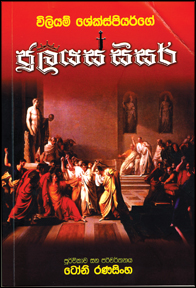
A moving translation
Julius Caesar - Translation by Tony Ranasinghe:
Reviewed by Dr. Lakshmi DE SILVA
"Each man in his time plays many parts" but few with as much
distinction and such a firm grasp of technique as Tony Ranasinghe. As
the conscience-haunted protagonist in Delovak Atara and the aged
romantic lead in Pavuru Walalu he proved his powers as a film actor,
while his bitter and dignified Shylock showed his understanding of the
demands of the stage and Shakespeare. His experience as a script writer
must have developed skills which have served him well in his translation
of Julius Caesar.
 A long acquaintance with the text, which I studied as a schoolgirl
and gave lectures on, to undergraduates at Kelaniya in the late 90s,
sharpened my urge to read the Sinhala version. My impressions of the
original perhaps coloured by vivid memories of Marlon Brando as Mark
Antony and Haig Karunaratne's riveting modern dress production, which
featured Winston Serasinghe as Caesar, K. K. Breckenridge as Brutus and
Richard de Zoysa as an electrifying Antony and as a translator familiar
with the limitations imposed by our craft, I wondered how the version
would match my expectations. I feared errors induced by reverence: would
the towering stature of the original, the aura of Roman grandeur clog it
with ponderous words and freeze the tension and turbulence of this
ironic drama of political manipulation? A long acquaintance with the text, which I studied as a schoolgirl
and gave lectures on, to undergraduates at Kelaniya in the late 90s,
sharpened my urge to read the Sinhala version. My impressions of the
original perhaps coloured by vivid memories of Marlon Brando as Mark
Antony and Haig Karunaratne's riveting modern dress production, which
featured Winston Serasinghe as Caesar, K. K. Breckenridge as Brutus and
Richard de Zoysa as an electrifying Antony and as a translator familiar
with the limitations imposed by our craft, I wondered how the version
would match my expectations. I feared errors induced by reverence: would
the towering stature of the original, the aura of Roman grandeur clog it
with ponderous words and freeze the tension and turbulence of this
ironic drama of political manipulation?
Now I am happy to concur with D. C. Ranatunga's verdict "Tony's
language is lucid. His choice of words is just correct to fit the
different situations and moods." Sensitive and sinewy, straightforward
enough to reach the mind with no delay over meaning, the language
reflects the rapid pulsing of life, conflicting agendas and beliefs and
the clash of temperaments; it catches the individual accents of the
different characters - contrast Casca and Caesar, Calpurnia and Portia.
Ranasinghe has found a vigorous and flexible equivalent for the iambic
pentameter. This particular play is marked by accessibility, making it a
good choice for translation; it also calls for rapidity and force of
movement in the lines, and this is deftly achieved.
What first strikes the reader is the absence of literary Sinhala:
with the exception of 'saerada', a few 'ahos' 'vijjulata' and 'ehev' the
translator sticks firmly to familiar words and phrases. It is evident
that it is with the intention of bringing the reader or listener
emotionally close to the text that Ranasinghe uses not only colloquial
Sinhala but adheres to the Sinhala of today - using for instance 'thaththala-ammala'
rather than 'piyavarun-mavuvarun'. Cassius long speech to Casca is
excellent rendered in all its forcefulness. More strikingly Mark
Antony's key speeches over the corpse - "O mighty Caesar" and "O pardon
me, thou bleeding piece of earth" are given their full value and that
ultimate test, the two funeral orations are brought off triumphantly,
since the translator conveys the individual tone of each speaker; he
admirably captures the antithetic structure of Brutus speech, with its
rhetorical balanced and opposed concepts and its marked contrast with
the living energy and manipulative force of Antony's eloquence. Both are
rendered with a fine understanding of Shakespeare's characterisation of
the speakers and their motivation.
This is the kind of transparent translation that illuminates and
reveals the original text through a different languages, in this
instance colloquial Sinhala. There may be unrealistic critics who demand
a more high-flown idiom: euphonic, rich and expressive as it is that
idiom is a barrier to communication.
If the language of Sarachchandra's dramas was used, flexible,
poignant and richly expressive as it is for the few who know it, it
might have made Julius Caesar inaccessible to many readers longing to
know Shakespeare's drama.
Instantaneous understanding of dialogue ensures a strong impact on an
audience. Ranasinghe's familiarity with the stage has resulted in a bold
approach beneficial to the translation. It is evident that it was a
conscious choice, from the erudite terms such as "bhavika
prathikampanaya" "uthkrushta" and "Vishayathikranthaya" which Ranasinghe
employs in the illustrated and richly informative 167 page preface
packed with biographical data on the playwright, his historical
background with the conflict between the Catholic faith and the Church
of England set up by Henry VIII which exposed secret believers in the
old religion such as Shakespeare's parents to the threat of martyrdom.
There is much theatre and literary history studded with colourful
episodes involving figures such as Richard Burbage, Marlowe, Kyd and
Jonson.
It concludes with a detailed analysis of the play. This introduction
which opens new horizons to the monolingual reader will prove useful to
students who study Drama for the A-levels.
Tony Ranasinghe should be congratulated for a moving translation of
Julius Caesar, and a worthwhile contribution to the cultural resources
of the Sinhala reader. |

